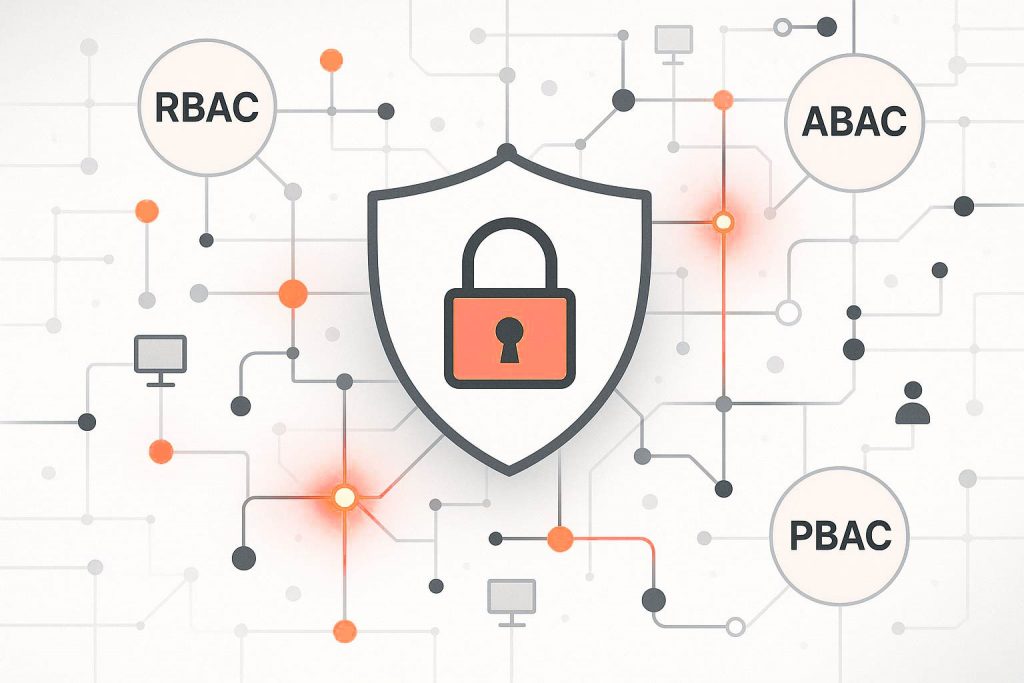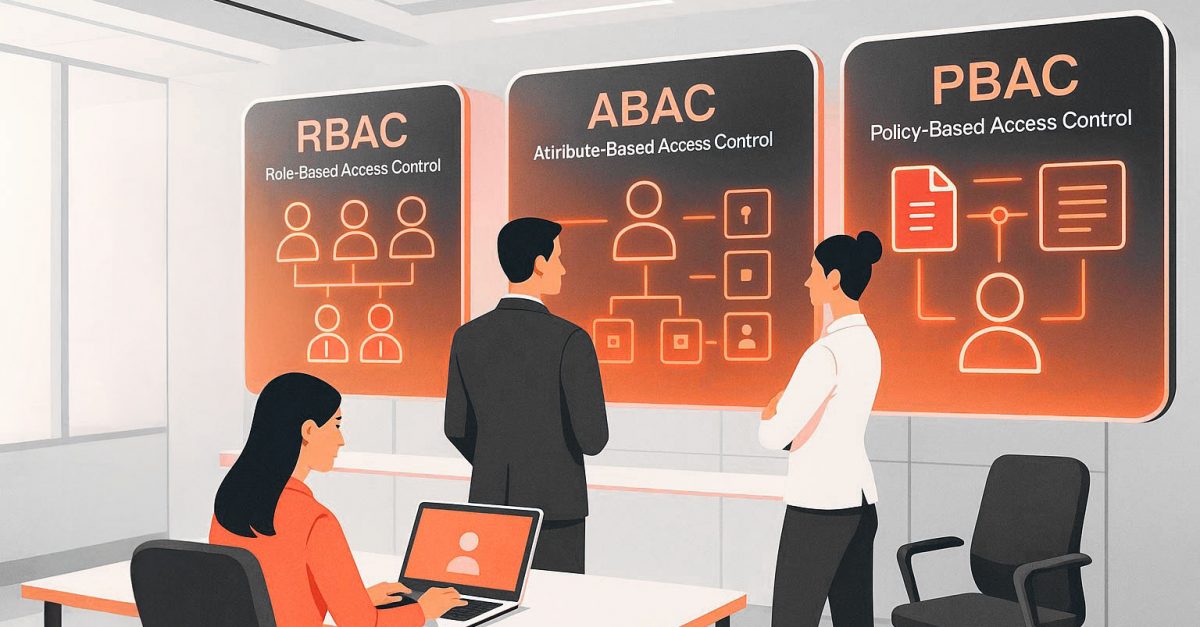It’s 3 AM when your phone buzzes with an alert. Someone just accessed your company’s financial records using an unrecognized device from a country where you don’t even have an office. Is it the CFO working while on vacation, or a security breach in progress?
This scenario happens more often than you’d think. The difference between being headline news and just another day at the office usually comes down to one thing: how well you’ve implemented your access control system.
Access control isn’t just for compliance purposes. It’s the digital equivalent of deciding who gets a key to which doors in your building. But unlike physical keys, digital access needs to be smarter, more flexible, and capable of adapting to constantly changing circumstances.
Let’s break down the three major access control models that organizations rely on today: Role-Based Access Control (RBAC), Attribute-Based Access Control (ABAC), and Policy-Based Access Control (PBAC). We’ll explore what makes each one tick, where they shine, where they fall short, and help you figure out which one might be the best fit for your organization.

Understanding the Basics of Access Control
Before diving into specific models, let’s clarify what we’re talking about. At its core, access control answers a simple question: “Should this person be allowed to do this thing with this resource?” But answering that in today’s complex IT environments is anything but simple.
Good access control needs to balance security (keeping the bad actors out) with usability (letting the right people in without unnecessary friction). Tilt that balance in either direction, and you’ve got problems: too permissive, and you risk a breach; too restrictive, and productivity suffers as legitimate users can’t do their jobs.
Now let’s explore each model in detail.
Role-Based Access Control (RBAC): The Classic Approach
What Is RBAC?
Role-Based Access Control is the access management veteran. It’s been around since the 1990s and remains widely used because of its straightforward approach: access permissions are assigned to roles, and users are assigned to roles.
RBAC simplifies access management by grouping permissions into predefined roles that match job functions or responsibilities in an organization. Users are then assigned to the appropriate roles based on their position, automatically receiving all the permissions associated with those roles. In RBAC, a user might be assigned the role of “Finance Manager,” which automatically grants them all the access permissions that a finance manager needs.
How RBAC Works
The implementation of RBAC follows a simple formula:
- Define roles: Create roles that align with job functions in your organization (HR Specialist, IT Admin, Marketing Associate, etc.)
- Assign permissions to roles: Determine what each role needs to access to perform its function
- Assign users to roles: Place each user in the appropriate role(s)
When a user attempts to access a resource, the system checks: “Does any role this user has include permission to perform this action on this resource?” If yes, access is granted. If no, it’s denied.
RBAC Pros
Simplicity: The most obvious advantage of RBAC is its simplicity. It’s easy to understand, implement, and manage, especially for organizations with a clear hierarchy and well-defined job functions.
Reduced administrative overhead: When a new employee joins as a Sales Representative, you simply assign them the “Sales Rep” role, and they automatically get all the permissions they need. No need to configure individual permissions for each new hire.
Compliance friendly: Many regulatory frameworks specifically mention role-based controls, making RBAC a safe choice for organizations in highly regulated industries.
Easier auditing: With RBAC, it’s relatively straightforward to see who has access to what by looking at role assignments.
RBAC Cons
Limited flexibility: RBAC becomes unwieldy when users need slightly different permissions than their standard role provides. This often leads to “role explosion,” where administrators create dozens or hundreds of highly specific roles to accommodate edge cases.
No context awareness: RBAC can’t adapt to changing circumstances. A user either has a role or doesn’t, regardless of where they’re logging in from, what time it is, or what device they’re using.
Struggles with fine-grained control: In complex environments, RBAC often becomes too coarse. For example, a “Doctor” role might grant access to all patient records when ideally doctors should only access records for their own patients.
Not user-attribute sensitive: RBAC doesn’t easily account for user attributes like department, location, or certification status without creating separate roles for each combination.
Attribute-Based Access Control (ABAC): The Flexible Alternative
What Is ABAC?
If RBAC is about “who you are” in the organization, ABAC is about “what’s true about you, the resource, and the situation.” Attribute-Based Access Control makes access decisions based on attributes (characteristics) of users, resources, actions, and environments.
Rather than pre-defining roles with fixed permissions, ABAC evaluates multiple factors in real-time to determine if access should be granted. It’s like having a bouncer who doesn’t just check if your name is on the guest list but also considers the time of day, how crowded the venue is, what you’re wearing, and even the weather before deciding whether to let you in.
How ABAC Works
ABAC relies on policies that use if-then statements to evaluate attributes:
- User attributes: Job title, department, clearance level, training certifications
- Resource attributes: Classification level, owner, data type, sensitivity
- Action attributes: Read, write, delete, approve
- Environment attributes: Location, time, device security status, network
A typical ABAC policy might look like this: “If the user is a doctor AND the patient record belongs to a patient under the doctor’s care AND the access occurs during business hours, THEN allow read access.”
When a user requests access, the system gathers all relevant attributes and evaluates them against the policy to make a decision.
ABAC Pros
Contextual awareness: ABAC can make decisions based on the full context of the access request, not just who the user is. This enables scenarios like restricting access outside of business hours or requiring additional verification when connecting from an unusual location.
Fine-grained control: With ABAC, you can create very specific conditions for access, like “Marketing managers can edit marketing materials for their own region if the materials haven’t been published yet.”
Reduced administration for complex scenarios: While initial setup is more complex, ABAC can reduce ongoing administration because you don’t need to create new roles for every unique access scenario.
Future-proofing: ABAC policies can be written to incorporate new attributes as they become relevant, making it adaptable to changing business needs without complete redesigns.
ABAC Cons
Complexity: ABAC policies can become extremely complex and difficult to manage without specialized tools. Writing effective policies requires deep understanding of both the business context and policy language.
Performance considerations: Evaluating multiple attributes in real-time may introduce latency, especially in large environments with many users and resources.
Initial implementation challenges: Setting up ABAC requires significant upfront work to identify and classify all relevant attributes and define the relationships between them.
Harder to audit: Understanding who has access to what is more difficult with ABAC because access depends on multiple variables that change over time, not just static role assignments.
Policy-Based Access Control (PBAC): The Evolution
What Is PBAC?
Policy-Based Access Control represents the next step in the evolution of access management. While it shares similarities with ABAC, PBAC adds another layer by centralizing policies and making them more dynamic and business-focused.
PBAC is like having a comprehensive rulebook that not only considers all the factors that ABAC does but also incorporates broader business rules, risk assessments, and even AI-driven insights to make access decisions.
How PBAC Works
PBAC builds on the attribute evaluation of ABAC but adds several important elements:
- Centralized policy management: Policies are defined at an organizational level and applied consistently across all systems
- Natural language policies: Policies can be written in business terms rather than technical specifications
- Dynamic risk assessment: Access decisions can incorporate real-time risk scoring
- Policy orchestration: Multiple policies can work together to make complex decisions
In a PBAC system, policies might look more like this: “Allow access to customer financial data only when required for active cases, by employees who have completed annual privacy training, with higher scrutiny applied to remote access requests.”
PBAC Pros
Business alignment: PBAC allows security policies to be expressed in terms that business stakeholders understand, bridging the gap between security requirements and business objectives.
Adaptability: PBAC can adapt to changing conditions more easily than other models, with policies that can be updated centrally without modifying individual applications or systems.
Comprehensive control: By encompassing elements of both RBAC and ABAC while adding policy orchestration, PBAC offers the most complete access control capability.
Automated governance: PBAC supports continuous monitoring and automated remediation of policy violations, reducing the manual overhead of compliance.
PBAC Cons
Maturity requirements: Implementing PBAC effectively requires a mature security program with well-defined processes and governance structures.
Tool dependency: Most organizations need specialized tools to implement PBAC, as it’s too complex to manage manually or with basic identity management solutions.
Resource intensive: The comprehensive nature of PBAC means it typically requires more computing resources and more skilled personnel to implement and maintain.
Potential overengineering: For smaller organizations with simpler needs, PBAC may represent overengineering, adding unnecessary complexity to what could be handled with simpler approaches.

Model Comparison: RBAC vs ABAC vs PBAC
| Feature | RBAC | ABAC | PBAC |
| Complexity | Low | Medium | High |
| Flexibility | Low | Medium | High |
| Context Awareness | None | High | Very High |
| Implementation Effort | Low | Medium | High |
| Maintenance Effort | Medium (Role Explosion) | Medium | Low (Centralized) |
| Scalability | Limited | Good | Excellent |
| Suitability for Dynamic Environments | Poor | Good | Excellent |
| Audit Complexity | Low | Medium | Low (with right tools) |
How Admin By Request Helps with Any Access Control Model
No matter which access control model your organization follows, implementing effective controls at the endpoint level remains a challenge. This is where Admin By Request’s Endpoint Privilege Management (EPM) solution shines.
Admin By Request works as a complementary layer to your chosen access control model, focusing specifically on controlling administrative privileges on endpoints, which is often the most vulnerable point in your security architecture.
Enhancing RBAC with Just-in-Time Privilege Elevation
If you’re using RBAC, you’ve likely encountered the dilemma of whether to include admin rights in certain roles. Including them creates security risks, but excluding them gets in the way of productivity.
Admin By Request solves this by elevating applications, not users. Your RBAC model can remain streamlined without “role explosion” because you don’t need separate roles for users who occasionally need admin privileges. Instead, users can request elevation for specific applications when needed, maintaining the principle of least privilege while preserving productivity.
Adding Context to ABAC with Comprehensive Logging
For organizations implementing ABAC, Admin By Request provides valuable contextual information about privilege usage. Every elevation request is fully logged, capturing details about the user, the application, the time, and even the reason for elevation if required.
This rich contextual data becomes another attribute set that can feed into your ABAC policies, allowing for more informed access decisions based on historical privilege usage patterns.
Supporting PBAC with Policy Enforcement at the Endpoint
When it comes to PBAC, Admin By Request delivers powerful enforcement at the endpoint level, which is typically the most vulnerable part of your security architecture.
The Just-In-Time approach aligns perfectly with policy-based frameworks by granting admin rights only for specific applications when needed, then automatically removing those rights when the task is complete. This precision control, combined with comprehensive audit logging, creates the accountability and visibility that effective policy-based approaches require. Your security team gets both the enforcement capability and the verification data they need to maintain a strong security posture.
Illustrative Examples: Access Control in Different Organizations
Let’s look at a few hypothetical examples to see how different organizations might implement these access control models with Admin By Request to address their specific challenges.
1. Healthcare Provider (2,500 employees)
Challenge: Doctors and nurses need access to patient records, but only for patients under their care. IT staff need to support clinical applications without having unnecessary access to patient data.
Solution: This organization implemented ABAC for their clinical systems, with attributes including provider role, patient-provider relationships, and department assignments. They could complement this with Admin By Request EPM to enable IT support staff to elevate privileges for troubleshooting clinical applications without granting them full admin rights across all systems.
Outcome: Patient data remains protected while care providers maintain appropriate access to the records they need. IT support can address technical issues without compromising patient information security.
2. Financial Services Firm (500 employees)
Challenge: Strict regulatory requirements demand precise control over who can access financial systems, with different rules applying to production versus test environments.
Solution: The firm chose RBAC for its clarity and compliance-friendly nature, defining specific roles aligned with regulatory requirements. They could then integrate Admin By Request EPM to prevent privilege escalation, ensuring that even if credentials were compromised, the damage would be limited.
Outcome: The company maintains strong compliance positioning. When facing a phishing attempt that captured an employee’s credentials, the organization is protected as the attackers can’t install malware due to the just-in-time privilege elevation controls.
3. Global Manufacturing Company (10,000+ employees)
Challenge: With operations in dozens of countries, the company needs an access control model that can adapt to different regional regulations while maintaining consistent security standards.
Solution: They implemented PBAC to centralize policy management while accommodating regional variations. Admin By Request was deployed across their endpoints to provide consistent privilege management, with settings tailored to address specific requirements in each region.
Outcome: The company strengthened their security posture while streamlining access control administration. The unified approach simplified management across their global IT operations while still respecting regional differences.
Practical Implementation Tips
Regardless of which access control model you choose, these practical tips can help ensure a successful implementation:
For Organizations Implementing RBAC:
- Start with the principle of least privilege: Define roles based on the minimum access needed to perform job functions, not current access levels (which often include unnecessary privileges).
- Create a role review process: Establish regular reviews of role definitions and assignments to prevent role drift and accumulation of unnecessary permissions.
- Plan for exceptions: Even with well-designed roles, you’ll have exceptions. Create a clear process for handling them without compromising your security model.
- Use Admin By Request as your safety net: Instead of creating numerous roles to handle occasional admin needs, use Admin By Request EPM to provide just-in-time elevation when necessary.
For Organizations Implementing ABAC:
- Inventory your attributes: Before designing policies, create a comprehensive inventory of the user, resource, action, and environment attributes available to you.
- Start simple and iterate: Begin with basic attribute-based policies and gradually introduce more complexity as you gain experience.
- Test extensively: ABAC policies can have unexpected interactions. Test thoroughly to ensure they produce the desired outcomes across different scenarios.
- Monitor performance impacts: Watch for any latency introduced by attribute evaluation, especially for frequently accessed resources.
For Organizations Implementing PBAC:
- Involve business stakeholders: Since PBAC connects technical controls to business objectives, involve non-technical stakeholders in policy development from the start.
- Invest in policy lifecycle management: Create clear processes for developing, testing, approving, implementing, and retiring policies.
- Build a common vocabulary: Ensure technical and business teams share a common understanding of policy terms to avoid miscommunication.
- Start with high-value assets: Focus your initial PBAC implementation on your most sensitive data and systems before expanding to less critical resources.
Finding Your Path Forward
Choosing between RBAC, ABAC, and PBAC isn’t about picking the “best” model in abstract terms. It’s about finding the right fit for your organization’s size, complexity, security needs, and operational requirements.
Many organizations actually implement hybrid approaches. They might use RBAC for the majority of their systems where role definitions are clear and stable, ABAC for sensitive systems that require contextual decisions, and PBAC for their crown jewel assets that warrant the highest level of protection.
The most important thing is to start with a clear understanding of what you’re protecting and why. Security is never one-size-fits-all, and access control is no exception to that rule.
No matter which path you choose, Admin By Request can help you implement the principle of least privilege at the endpoint level, adding a crucial layer of protection that complements any access control model. By elevating applications rather than users, you can maintain tight control over administrative privileges without slowing people down.
Ready to see how Admin By Request can strengthen your access control strategy? Sign up for our free plan or book a demo to see our solutions in action.







